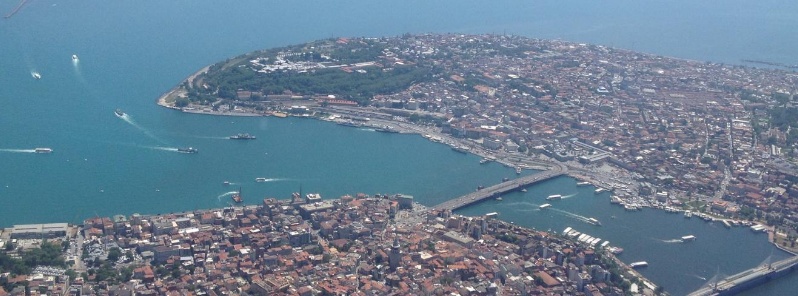Study: Ultra-slow earthquake indicates deep crustal movement near Istanbul, Turkey

GFZ Potsdam scientists analyzed a large transient strainmeter signal recorded along the southern shore of the eastern Sea of Marmara region in northwestern Turkey after M4.4 earthquake. The strain signal lasted about 50 days, indicating deep crustal movement near Istambul.
The analysis allowed us to identify the slow slip signal that presumably occurred at mid-crustal depth level and that is of the same size as the largest ever seen such signal that occurred along the San Andreas Fault in California, says Dr. Martínez-Garzón, lead-author of the study published in the journal Earth and Planetary Science Letters.
The study reports on a large 2-month lasting ultra-slow earthquake that occurred south of Istanbul below the Sea of Marmara in conjunction with elevated moderate-sized seismicity at shallow depth in the region.
The strain signal was recorded at the Esenkoy site by one of the ICDP-GONAF strainmeters on the Armutlu peninsula with a maximum amplitude of 5 microstrain and lasting about 50 days.
During this aseismic slow deformation signal the shallower and typically fully locked part of the earth crust responded by producing the highest number of moderate earthquakes in years indicating an interaction between near-surface and deep crustal deformation.
"How this interaction works remains to be understood in detail. In any case, our results will allow to better understand and quantify the regional seismic risk, in particular for the 15-million population center of Istanbul in the light of the pending big one." said Prof. Marco Bohnhoff, head of the GONAF observatory and a co-author of the study.
The onset of the strain signal coincided with the origin time of a MW 4.4 earthquake offshore Yalova, which occurred as part of a seismic sequence including eight MW ≥3.5 earthquakes.
The MW 4.4 event occurred at a distance of about 30 km (18 miles) from Esenkoy on June 25, 2016 representing the largest earthquake in this region since 2008.
Before the event, the maximum horizontal strain was subparallel to the regional maximum horizontal stress derived from stress inversion of local seismicity.
"During the strain transient, we observe a clockwise rotation in the local horizontal strain field of about 20°," the authors said in abstract of the paper. The strain signal does not correlate with known environmental parameters such as annual changes of sea level, rainfall or temperature. The signal could indicate local slow slip on the Cinarcik fault and thus a transfer of stress to the eastern Marmara seismic gap.
The region south of Istanbul is part of the North Anatolian Fault, separating Eurasia from the Anatolian plate. This geological fault is a large tectonic plate boundary known to generate destructive earthquakes causing large numbers of casualties. The last such major earthquake occurred in 1999 near Izmit causing almost 20 000 fatalities.
A portion of the fault, running just south of the densely populated mega-city of Istanbul, is currently identified as a "seismic gap" and overdue to produce a large earthquake.
While the tectonic loading due to plate motion is continuous thereby accumulating elastic energy on faults day-by-day, the release of the stored energy can occur either seismically in the form of earthquakes, or aseismically during fault creep or slow deformation at depth. Understanding the interaction between both phenomena is critically important to define the seismic hazard and subsequent risk in urban areas.
Reference:
"Slow strain release along the eastern Marmara region offshore Istanbul in conjunction with enhanced local seismic moment release" – Patricia Martínez-Garzón et al. – Earth and Planetary Science Letters Volume 510, 15 March 2019, Pages 209-218 – https://doi.org/10.1016/j.epsl.2019.01.001
Featured image credit: Marco Bohnhoff/GFZ

Commenting rules and guidelines
We value the thoughts and opinions of our readers and welcome healthy discussions on our website. In order to maintain a respectful and positive community, we ask that all commenters follow these rules.